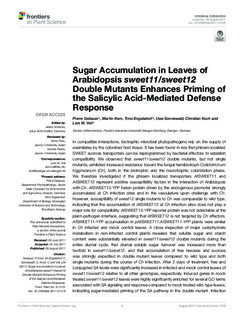| dc.contributor.author | Gebauer, Pierre | |
| dc.contributor.author | Korn, Martin | |
| dc.contributor.author | Engelsdorf, Timo | |
| dc.contributor.author | Sonnewald, Uwe | |
| dc.contributor.author | Koch, Christian | |
| dc.contributor.author | Voll, Lars M | |
| dc.date.accessioned | 2018-07-30T08:00:36Z | |
| dc.date.available | 2018-07-30T08:00:36Z | |
| dc.date.created | 2018-01-05T12:04:52Z | |
| dc.date.issued | 2017 | |
| dc.identifier.citation | Frontiers in Plant Science. 2017, 8. | nb_NO |
| dc.identifier.issn | 1664-462X | |
| dc.identifier.uri | http://hdl.handle.net/11250/2506713 | |
| dc.description.abstract | In compatible interactions, biotrophic microbial phytopathogens rely on the supply of assimilates by the colonized host tissue. It has been found in rice that phloem localized SWEET sucrose transporters can be reprogrammed by bacterial effectors to establish compatibility. We observed that sweet11/sweet12 double mutants, but not single mutants, exhibited increased resistance toward the fungal hemibiotroph Colletotrichum higginsianum (Ch), both in the biotrophic and the necrotrophic colonization phase. We therefore investigated if the phloem localized transporters AtSWEET11 and AtSWEET12 represent additive susceptibility factors in the interaction of Arabidopsis with Ch. AtSWEET12-YFP fusion protein driven by the endogenous promoter strongly accumulated at Ch infection sites and in the vasculature upon challenge with Ch. However, susceptibility of sweet12 single mutants to Ch was comparable to wild type, indicating that the accumulation of AtSWEET12 at Ch infection sites does not play a major role for compatibility. AtSWEET12-YFP reporter protein was not detectable at the plant–pathogen interface, suggesting that AtSWEET12 is not targeted by Ch effectors. AtSWEET11-YFP accumulation in pAtSWEET11:AtSWEET11-YFP plants were similar in Ch infected and mock control leaves. A close inspection of major carbohydrate metabolism in non-infected control plants revealed that soluble sugar and starch content were substantially elevated in sweet11/sweet12 double mutants during the entire diurnal cycle, that diurnal soluble sugar turnover was increased more than twofold in sweet11/sweet12, and that accumulation of free hexoses and sucrose was strongly expedited in double mutant leaves compared to wild type and both single mutants during the course of Ch infection. After 2 days of treatment, free and conjugated SA levels were significantly increased in infected and mock control leaves of sweet11/sweet12 relative to all other genotypes, respectively. Induced genes in mock treated sweet11/sweet12 leaves were highly significantly enriched for several GO terms associated with SA signaling and response compared to mock treated wild-type leaves, indicating sugar-mediated priming of the SA pathway in the double mutant. Infection assays with salicylic acid deficient sweet11/sweet12/sid2 triple mutants demonstrated that reduced susceptibility observed in sweet11/sweet12 was entirely dependent on the SA pathway. We suggest a model how defects in phloem loading of sucrose can influence SA priming and hence, compatibility. | nb_NO |
| dc.language.iso | eng | nb_NO |
| dc.publisher | Frontiers | nb_NO |
| dc.rights | Navngivelse 4.0 Internasjonal | * |
| dc.rights.uri | http://creativecommons.org/licenses/by/4.0/deed.no | * |
| dc.title | Sugar accumulation in leaves of arabidopsis sweet11/sweet12 double mutants enhances priming of the salicylic acid-mediated defense response | nb_NO |
| dc.type | Journal article | nb_NO |
| dc.type | Peer reviewed | nb_NO |
| dc.description.version | publishedVersion | nb_NO |
| dc.source.pagenumber | 13 | nb_NO |
| dc.source.volume | 8 | nb_NO |
| dc.source.journal | Frontiers in Plant Science | nb_NO |
| dc.identifier.doi | 10.3389/fpls.2017.01378 | |
| dc.identifier.cristin | 1536546 | |
| dc.description.localcode | © 2017 Gebauer, Korn, Engelsdorf, Sonnewald, Koch and Voll. This is an open-access article distributed under the terms of the Creative Commons Attribution License (CC BY). The use, distribution or reproduction in other forums is permitted, provided the original author(s) or licensor are credited and that the original publication in this journal is cited, in accordance with accepted academic practice. No use, distribution or reproduction is permitted which does not comply with these terms. | nb_NO |
| cristin.unitcode | 194,66,10,0 | |
| cristin.unitname | Institutt for biologi | |
| cristin.ispublished | true | |
| cristin.fulltext | original | |
| cristin.qualitycode | 1 | |

